
An Upper Geyser Basin winter vista, Yellowstone National Park / Rebecca Latson
Photographing Yellowstone National Park in the winter has long been on my bucket list, so this past February, I loaded up the vehicle and drove 12 hours to the park’s northern entrance. From there, I rode a snowcoach to Old Faithful Snow Lodge for a few days, then returned to Mammoth Hot Springs for a couple more days to explore the Mammoth travertine terraces, Norris Geyser Basin, and the Lamar Valley landscape. My experience was incredible and I captured some wonderful images I’d like to share with you, along with tips and techniques to help you capture your own amazing images if you ever visit Yellowstone between December and early March.
If you’ve read the National Parks Traveler Checklist: Yellowstone In Winter, then you should be better prepared for tackling a visit during that particular season. This article is all about the photo ops, of which there are plenty!
Before you head out via car or plane, there are important things for which you should prep regarding yourself and your camera. First and foremost, pack plenty of spare batteries and don’t forget those battery chargers. It’s cold in Yellowstone during winter. Depending upon the time of your visit, the temps could get into the negative double digits! Brrrr! Camera and smartphone batteries run out of juice super quick in cold weather. The cameras I used for a day in the park usually ran very low on battery power after less than a half day, so I was glad to have toted along extras in my vest pocket. My iPhone battery would have run out even quicker had I not used it judiciously and placed it back in my pocket immediately after each use (I learned my lesson from my Glacier National Park visit).
In addition to warm, water-resistant clothing for yourself, bring along some protection for your camera in the form of a lens hood and some form of rain covering. BHPhoto.com and Adorama.com carry a wide selection of camera rain protection. I experienced snowfall ranging from large, fluffy, gently-falling flakes to white blurs of windblown pinpricks. My camera remained dry thanks to that “rain coat”, and the lens hood prevented snowflakes from dotting the lens front and smudging the view.

A snow-and-ice-packed boardwalk at Upper Geyser Basin, Yellowstone National Park / Rebecca Latson
Traction devices for your boots are practically a requirement. The boardwalks are solidly-packed thick “loaves” of ice and snow, and warm steam from any thermal feature close to the boardwalk will turn that packed snow and ice into thick strip of shiny, slick ice. I love my Kahtoola microspikes, but I saw plenty of people wearing Yaktrax-brand traction devices, too. You just need something “grippy” that will “bite” into the packed snow and ice to give you better stability. Most of the boardwalks do not have any railing between you and the thermal features, and an icy accident would put a kink in an otherwise perfect picture-taking day.
Take water with you on your daily photo jaunts. It may be cold, you may be surrounded by water in the form of snow, and you may not even feel thirsty at all, but you need that water. In general, the winter atmosphere is drier because there are not many water molecules in the air - which is the reason your winter photos always look so crisp and clear. Mix Yellowstone’s own dry atmosphere with the winter season’s dryness, and your body’s moisture will get sucked right out.
Now, let’s get to the photography part. Yellowstone in winter is pure magic.

A rime-iced vista near Beryl Spring, Yellowstone National Park / Rebecca Latson
You might see ghostly evergreen trees heavily veiled in steam from nearby hot springs or geysers, flocked with thick white rime ice created from that steam freezing to the branches.

Canada geese wading through Old Faithful runoff, Yellowstone National Park / Rebecca Latson
You might see Canada geese picking their way along the runoff from Old Faithful’s latest eruption.

Hunkered down in the snowstorm near Old Faithful, Yellowstone National Park / Rebecca Latson
You might see bison grazing near Old Faithful during a snowstorm, their faces matted with the snow they plowed aside to access the grass beneath.

Coyote offtrail, Yellowstone National Park / Rebecca Latson
You might meet a lone coyote on the same trail you’re hiking.

Wolf on the road, Yellowstone National Park / Rebecca Latson
You might see a wolf on the snowy road, padding right past your snowcoach.

Bison bones in Blue Star Spring, Yellowstone National Park / Rebecca Latson
You might see within the clear aquamarine water of Blue Star Spring (190 degrees F) the bones of a bison calf that fell into the spring back in the 80s.

Heat-loving greenery at Midway Basin, Yellowstone National Park / Rebecca Latson
You might notice patches of green vegetation growing within or next to hot flowing runoff, proving that life, does indeed, find a way even in the most inhospitable environments.

Bacterial mats and thermal activity at Upper Geyser Basin, Yellowstone National Park / Rebecca Latson
You might notice colorful bacterial mats carpeting the ground between the boardwalk and a geyser or thermal spring.
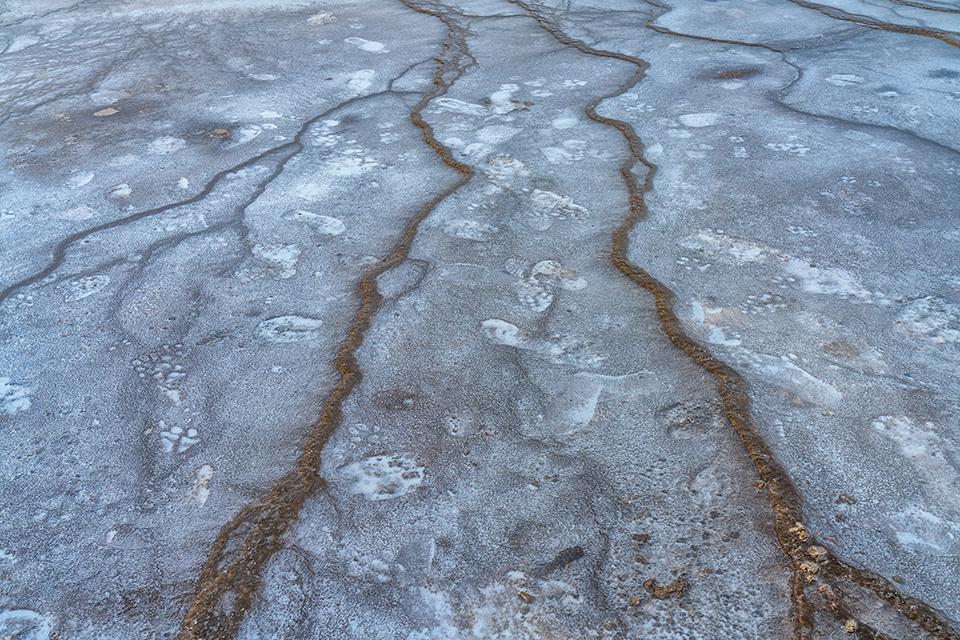
Boot, paw, and hoof prints on the shallow terraces of Grand Prismatic Spring, Midway Basin, Yellowstone National Park / Rebecca Latson
You might see the prints of bison, coyotes, wolves, or foxes on the shallow terraces at the edges of a steaming Grand Prismatic Spring. You might also (unfortunately) see human boot prints next to those bison prints in the terraces. Btw, that’s not snow in the photo. That white stuff is silica! The thermal waters of Yellowstone carry silica in solution. Once the water cools as it moves away from the heat source, the silica precipitates out, leaving a milky appearance to the ground or water.

Angry clouds over Lamar Valley landscape, Yellowstone National Park / Rebecca Latson
You might see angry clouds hovering over the rugged Absaroka Range northeast of the Lamar Valley.

The monochrome look of a frosty winter forest, Yellowstone National Park / Rebecca Latson
You might see white-frosted evergreens against a snowy white background, creating an almost monochromatic scene along the trail.
You might see all sorts of things you’d never see during any other season in Yellowstone. How do you capture all of this and more?
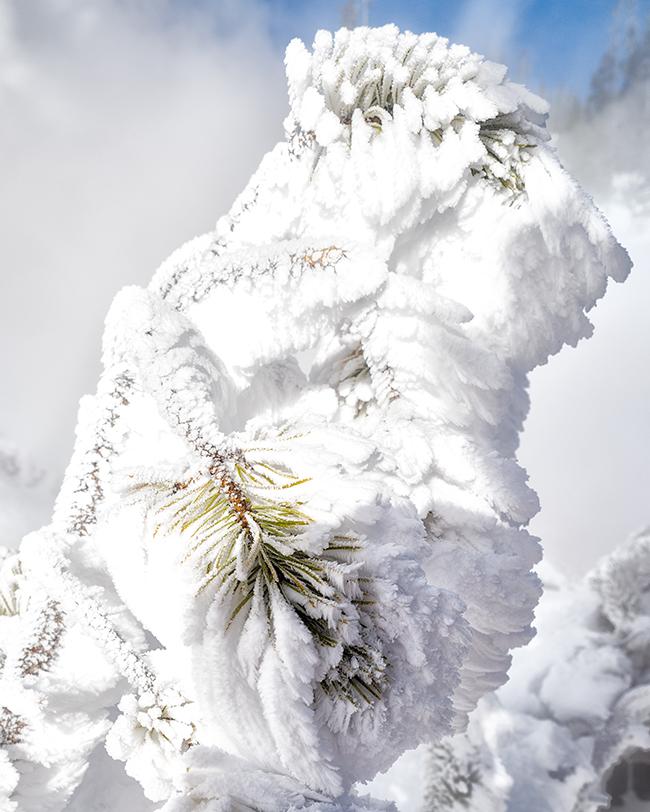
Evergreen needles caked with rime ice, Yellowstone National Park / Rebecca Latson
First and foremost, be observant of your surroundings. Be aware not only of the Big Picture Landscape, but also of the little things comprising that landscape, like the needles of rime-iced trees, or the paw (or hoof) prints through the snow, or the bison bones in the hot spring.
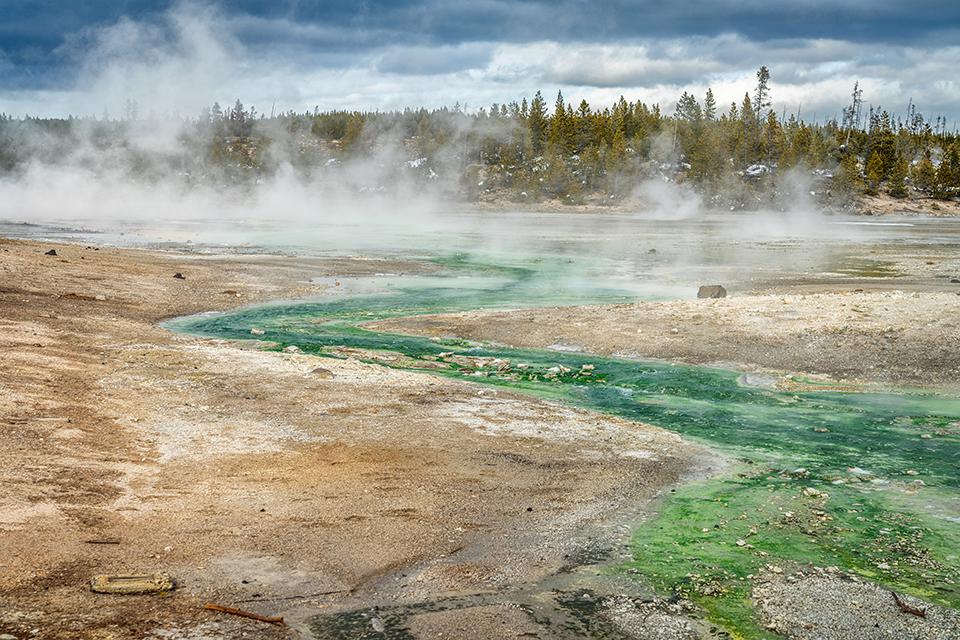
A strip of thermophilic algae at Porcelain Basin, Yellowstone National Park / Rebecca Latson
Look for patterns or leading lines, like this green curving strip of thermophilic (heat loving) algae in the warm-water stream weaving its way over the barren landscape of Porcelain Basin.

Ephydrid fly larvae and adults, Biscuit Basin, Yellowstone National Park / Rebecca Latson
Fill your frame with what you see. A close-up of little black rice shapes on a yellow bacterial mat at Biscuit Basin reveals those “rice grains” to be ephydrid fly larvae living in the hot water.

Travertine terrace colors and textures of Palette Spring at Mammoth, Yellowstone National Park / Rebecca Latson
Look for color and texture.

Hmmm, pleghm or thermophilic slime? Yellowstone National Park / Rebecca Latson
Photograph what interests you. Don’t just sidle up to another photographer out there because you think they’ve seen something awesome and have a great spot for a photo. That photographer may very well be photographing the heat-loving slime near a hot spring.

Morning Glory Pool on a freezing winter morning, Yellowstone National Park / Rebecca Latson
Think about how to frame your composition. Yes, there are only so many ways to photograph an iconic subject like Morning Glory Pool, but how can you frame it in a slightly different way? Try different techniques, such as the rule-of-thirds or the leading line technique. Don’t be afraid to photograph just a part of your view, as opposed to the entire view.
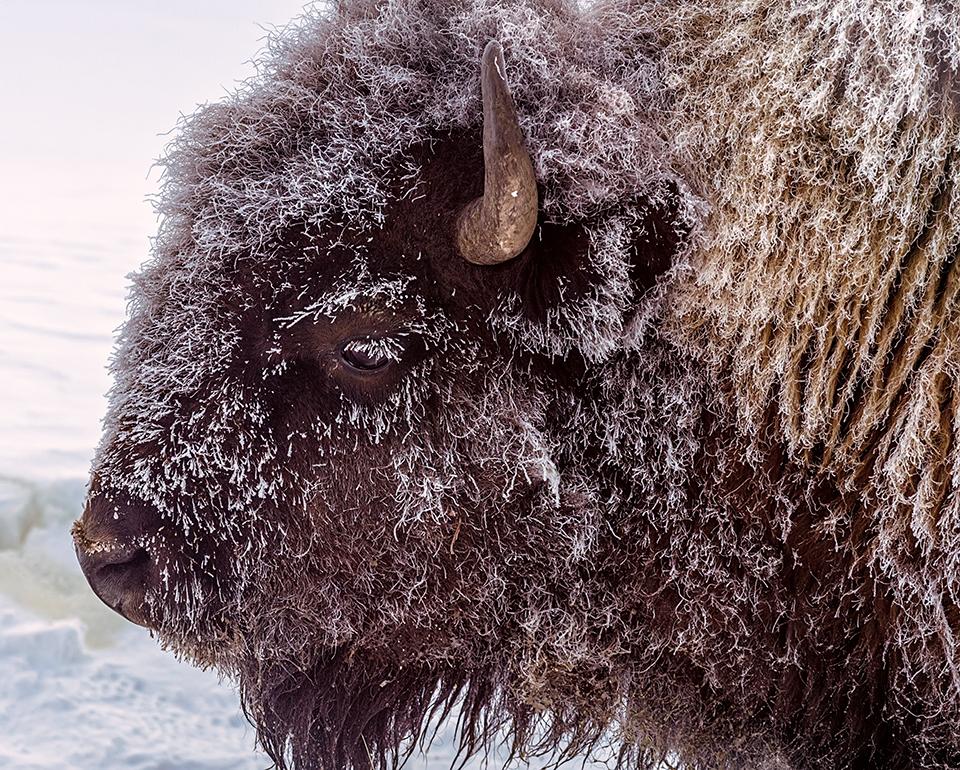
A frosty-faced bison on a freezing winter morning, Yellowstone National Park / Rebecca Latson

Bison and Yellowstone landscape, Yellowstone National Park / Rebecca Latson
We all dream of capturing gorgeous close-ups of wildlife we are lucky enough to spot, but that might not always work out and we might not always be carrying the right lens with us when the opportunity arises. This occurred more than once with me, and when that happened, I simply made the wildlife a part of my landscape shots, allowing the viewer to see the environment within which that one animal exists.
In a previous Yellowstone photography article, I noted that a circular polarizing lens helps immensely with bringing out the color and clarity of a hot spring by removing surface reflections. The same thing may be applied in the winter, if you can get around the constant thick steam issuing from the hot water into the freezing cold atmosphere. You might have to wait until the wind blows the steam away from you, then be quick with the shutter button before the wind changes yet again.

A morning scene along the boardwalk at Upper Geyser Basin, Yellowstone National Park / Rebecca Latson
If you’ve read any of my other winter photography articles, you’ll understand about how to keep snow white by working with in-camera settings or while editing the shot after the fact. Now, I want to throw a curveball and tell you that sometimes, that blue or yellow or even gray cast to the snow actually works well with the rest of your composition. What? In the image above, captured during an early morning walk along the boardwalks at Upper Geyser Basin, you can see the overall blue-gray tone to the darker portions of the shot. The snow, itself, is also a shiny sort of blue-gray-silver-white and looks good as-is with the rest of the composition.

A morning scene along Upper Geyser Basin converted to black-and-white, Yellowstone National Park / Rebecca Latson
For something even more different, try converting some of your shots to black-and-white and see what you might notice that you didn’t with your original color image. What stands out more for you? Textures? Patterns? Differences in light, dark, and shadows?

Hoof and paw prints on the shallow terraces of Grand Prismatic, Yellowstone National Park / Rebecca Latson
Try a little judicious vignetting with some of your images, to keep your viewer’s eyes focused on your main subject. Most photo editing programs and even plug-ins for your photo editor now have vignetting sliders or menu choices allowing you to apply a little (or a lot) of darkening around the corners and sides of the shot.

Cross-country skiers on the trail at Upper Geyser Basin, Yellowstone National Park / Rebecca Latson
Don’t forget to capture a few photos with people or man-made infrastructure. Those people add a sense of scale and reference and they show your viewers what kind of a good time may be had at Yellowstone (as if they needed any reminders of that).
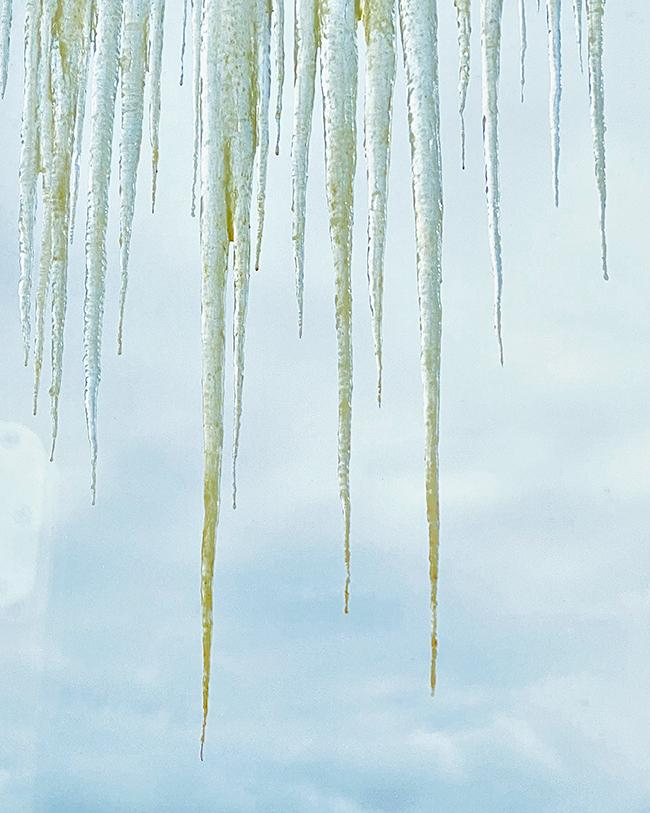
Yellow icicles, Yellowstone National Park / Rebecca Latson
Serendipity often plays a part in photography and you might see something totally unexpected in a location you’d never think to photograph. One afternoon, upon returning from a hike along the boardwalks of Upper Geyser Basin, I glanced out my lodge room window to see yellow icicles hanging down from the eaves. I could be wrong, but I believe sulfur colored those icicles. The smell of sulfur is everywhere (no duh), which means it’s in the air as particulate matter not only coloring icicles but also landing on your camera gear. Seeing those yellow icicles reminded me to wipe down my camera equipment with a damp cloth followed by a dry cloth. You should remember to do the same after a day photographing among the geysers (no matter which season you visit).
One last piece of advice: for each scene you visit and each photo you capture, before you push down on that shutter button, take a moment to look up and appreciate the cold magic of a Yellowstone winter with your own eyes and appreciate where you are in this national park. Watch the bison as they sway their huge, wooly heads back and forth to plow the snow into which they’ve buried their faces for the tasty grass beneath. Look closely at the green tree needles and the thick but delicate rime ice coating those needles. Breathe in the fresh, sulfur-tinctured air to remind yourself of the fragile volcanic crust on which you stand. Savor your winter day(s) in Yellowstone and return home with a checked bucket list, memories of one-of-a-kind experiences, and memory cards or smartphone photo libraries filled with snowy landscapes, steaming geysers, colorful thermal pools, and wildlife encountered (from a safe distance). That’s Yellowstone in winter.
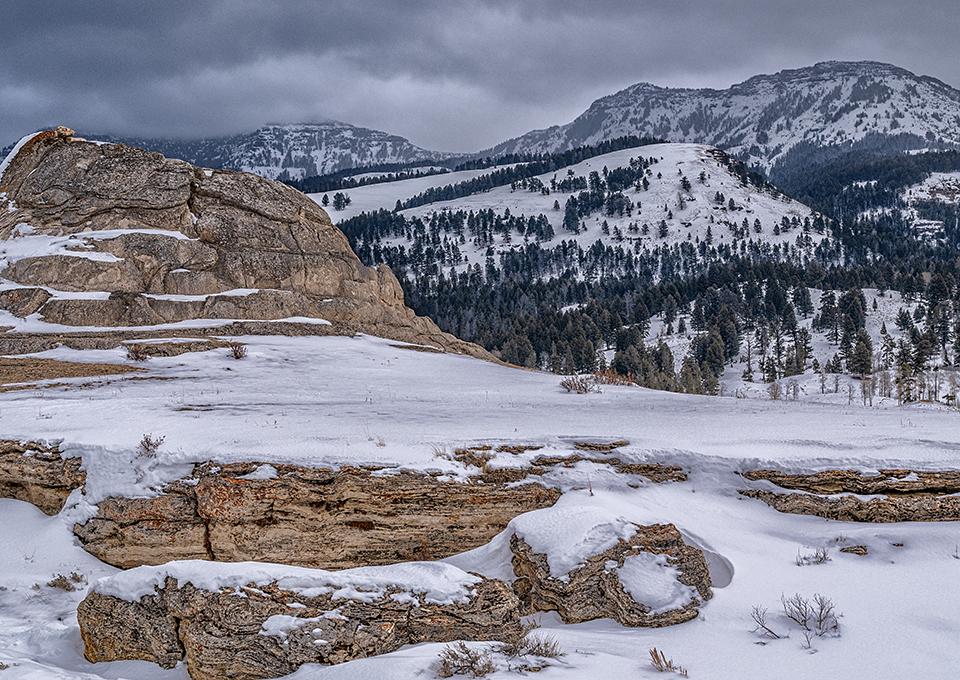
Soda Butte and the Absarokas, Yellowstone National Park / Rebecca Latson



Comments
Magnificent Photos!! Thank you.
And thank you, Bill, for the kind words.
Once more Rebecca, you've hit it out of the park (no pun intended)!! Great article and photos. Thanks!
Thanks so much, Chip! Your kind words are always appreciated. :)
Terrific photos! The close up of the bison showing frost on its eyelids is especially good. For me, black and white is the way to go for winter scenery. I'm sure you had some cold hands!
Beautiful. My favorite park.
Excellent work! Thanks for sharing.
Just beautiful! Lovely photos and great information. Makes me want to go back in winter!